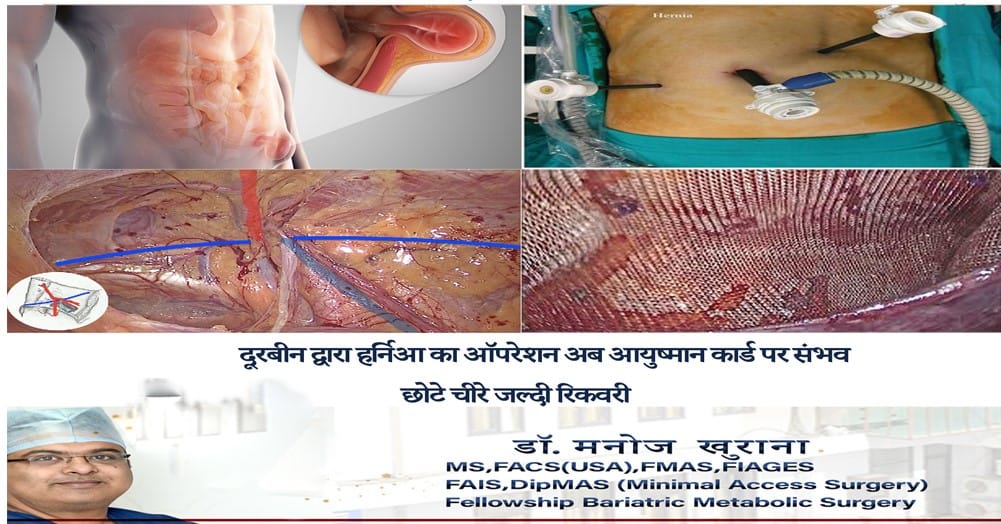What is Hernia
A hernia is a protrusion of internal organs through a hole or muscle weakness in the wall of the abdomen. A hernia occurs when fatty tissue or an organ pushes through a weak place in the surrounding connective tissue or muscle wall. They can be classified as per their location e.g., Inguinal, Umbilical, Supraumbilical, Epigastric & Ventral hernia. They can be named as per their cause like traumatic & incisional.Hernia surgery can be done by laparoscopy.

Hernias usually don’t get better on their own as they are structural abnormalities unless we repair the defect, they tend to get bigger. In rare cases, they can lead to life-threatening complications. That’s why doctors often recommend surgery.
A surgical hernia repair involves pushing the bulge back inside the body part that should contain it using mesh(a type of net used for surgical purposes) and keeping it there. your doctor will likely recommend it if any of these things happen:
- Tissue (such as the intestine) becomes trapped in the hernia. This is called incarceration. If left untreated, it may lead to loss of blood supply to organs and subsequently their death.
- The hernia becomes strangulated. This can cause permanent damage and is a surgical emergency. Strangulated organs, usually your intestines, will die, and if not removed quickly, you can become seriously ill. Call your doctor right away if you have a fever or nausea, sudden pain that gets worse, or a hernia that turns red, purple, or dark.
- The hernia causes pain or discomfort, or it’s growing larger.
You may be able to wait to have surgery
Your hernia goes away when you lie down, or you can push it back into your belly. This is called a reducible hernia.
Types of Hernia Surgery
Your doctor can remove your hernia in one of two ways. Both are done at a hospital or surgery center. You’ll usually go home within 2-3 days. In many cases, you’ll be able to go home the same day as your procedure.
Open surgery: You will receive anesthesia before having open surgery. The surgeon makes a cut (incision) to open your skin over the bulge. They’ll gently push the hernia (internal organs) back into place, or remove it in case of only external fat. Then they’ll close the weak area of the muscle — where the hernia pushed through — with stitches. For larger hernias, your surgeon may add a piece of flexible mesh for extra support. It’ll help keep the hernia from coming back.
Laparoscopic surgery: In this surgery, your abdomen is inflated with a co2 gas. This gives the surgeon a better look at your organs. They’ll make a few small incisions (cuts) near the hernia. They’ll insert a thin tube with a tiny camera on the end (laparoscope). The surgeon uses images from the laparoscope as a guide to repair the hernia with mesh. For laparoscopic surgery, you’ll receive general anesthesia.

A laparoscopic hernia repair typically takes one hour or less to complete
What kind of surgery you’ll need often depends on the size, type, and location of your hernia. Your doctor will also consider your lifestyle, health, and age.
How to prepare for hernia surgery /laparoscopic hernia repair
Pre-procedure instructions will be explained to patients by the surgeon. It may be necessary to stop eating and drinking for at least eight hours before the procedure. Patients taking prescription drugs should ask their doctor if they should continue taking their medications as usual on the days leading up to surgery. This is because certain medications can affect the body’s ability to clot blood, which can lead to complications during and/or after surgery.
Risks associated with hernia surgery/laparoscopic hernia repair
The nature of laparoscopic hernia repair as a minimally invasive surgery means that, when applied to appropriate situations, this technique is as safe as open repair procedures. However, as with any surgical procedure, there is a risk of certain complications. Some of these risks include:
- Reaction to the anesthesia
- Infection
- Recurrence of the hernia
Benefits of laparoscopic hernia repair
Minimally invasive, minimal incision techniques provide the following benefits to patients:
- Lower risk of infection
- Smaller incision size
- Shorter operating room (OR) times
- Earlier return to work and daily activities
- Less pain and shorter recovery time for some patients
Additionally, if necessary, laparoscopic techniques allow surgeons to repair multiple hernias using the same incisions.
Post laparoscopic hernia surgery
Most patients are able to go home the same day after a laparoscopic hernia repair procedure. However, the amount of time a patient is required to stay in the hospital following the procedure will depend on the patient’s overall health. Typically, patients can return to work within one week of surgery and can go back to their daily activities within one to two weeks. It is important to schedule and attend all follow-up appointments in addition to following all postoperative instructions that are given by the surgeon.
